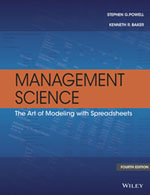About the Book
 This is a book for business analysts about modeling. A model is a simplified representation of a situation or problem, and modeling is the process of building, refining, and analyzing that representation for greater insight and improved decision making. Almost anyone who uses spreadsheets in business has been involved with models and can benefit from formal training in the use of models.
This is a book for business analysts about modeling. A model is a simplified representation of a situation or problem, and modeling is the process of building, refining, and analyzing that representation for greater insight and improved decision making. Almost anyone who uses spreadsheets in business has been involved with models and can benefit from formal training in the use of models.
Models also play a central role in management education. By using models, a business student can acquire a deep understanding of the various functional areas of business. But to fully understand the implications of these models, a student needs to appreciate what a model is and how to learn from it. Our book provides that knowledge.
With the spread of personal computers and electronic spreadsheets, managers and analysts can build their own models and produce their own analyses. This new kind of modeling is known as end-user modeling. In this environment, it becomes important to use time wisely in the modeling process. This book is designed to improve modeling efficiency by focusing on the most important tasks and suggesting how to avoid unproductive steps. This book is also designed to improve modeling effectiveness by introducing the most relevant analytic methods and emphasizing procedures that lead to the deepest business insights.
New in the Fourth Edition
In this Fourth Edition we have added material on Data Analysis and Data Mining, broadening our coverage to match the extended capabilities of Analytic Solver Platform for Education (ASPE). ASPE is an integrated add-in to Excel that performs sensitivity analysis, optimization, data mining, decision trees, and simulation.
To the Reader
Modeling, like painting or singing, cannot be learned entirely from a book. However, a book can establish principles, provide examples, and offer additional practice. We suggest that the reader take an active learning attitude toward this book. This means working to internalize the skills taught here by tackling as many new problems as possible. It also means applying these skills to everyday situations in other classes or on the job. Modeling expertise (as opposed to modeling appreciation) can be acquired only by doing modeling. There is no substitute for experience. The book is organized into four parts:
- Modeling with spreadsheets (Chapters 1–4)
- Data analysis (Chapters 5–7)
- Optimization (Chapters 8-12)
- Decision analysis and simulation (Chapters 13–15)
Students can find spreadsheet files for all models presented in the text on this website at the Text Figures link. For access to the Analytic Solver Platform for Education software, contact your course instructor or Frontline Systems (email academic@solver.com or call 775-831-0300.)
Software Accompanying the Text
Users of the Fourth Edition have access to spreadsheet files for all the models presented in the text on this website at the Text Figures link. Users also have access to Analytic Solver Platform for Education, an integrated software platform for sensitivity analysis, optimization, data mining, decision trees, and simulation.
Purchasers of this text (and its electronic version) have access to Analytic Solver Platform for Education either through their course instructor or Frontline Systems (email academic@solver.com or call 775-831-0300).
Table of Contents
1. Introduction
2. Modeling in a Problem-Solving Framework
3. Spreadsheet Engineering
4. Analysis Using Spreadsheets
5. Data Exploration and Preparation
6. Classification and Prediction Methods
7. Short-Term Forecasting
8. Nonlinear Optimization
9. Linear Optimization
10. Optimization of Network Models
11. Integer Optimization
12. Optimization of NonSmooth Models
13. Decision Analysis
14. Monte Carlo Simulation
15. Optimization in Simulation
Detailed Table of Contents (PDF file)